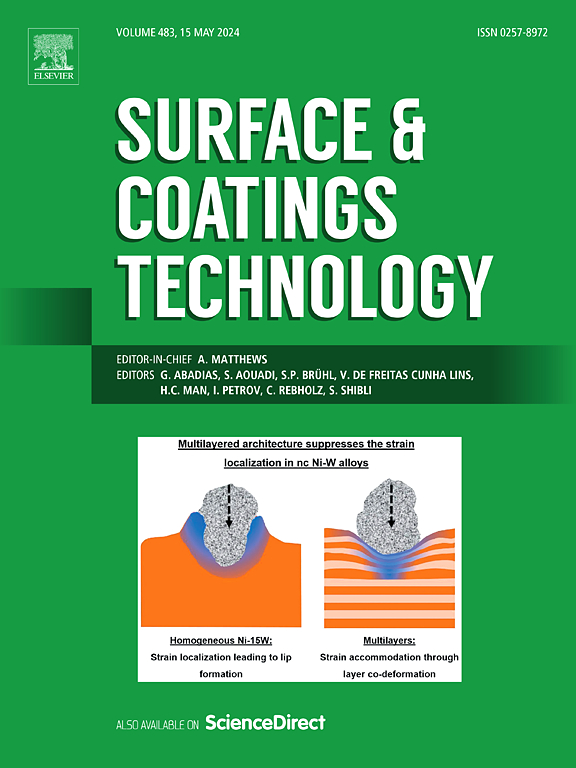Investigation on the growth mechanism and properties of AO-PEO composite coating on 304 stainless steel prepared by two-step process
IF 5.3
2区 材料科学
Q1 MATERIALS SCIENCE, COATINGS & FILMS
引用次数: 0
Abstract
Plasma electrolytic oxidation (PEO) technology is an effective means to improve the surface performance of metal parts, but this method is not suitable for non-valve metal 304 stainless steel. Because 304 stainless steel contains a large amount of Cr element, it will hinder the rise of voltage during the PEO process, thus causing the PEO process to fail. In order to achieve PEO on 304 stainless steel, anodic oxidation (AO) was used as a pretreatment in this study. The experimental outcomes display that compared to 304 stainless steel, after PEO treatment, the hardness of the sample enhanced by 139.32 %, the scratch width under 3 N and 5 N load conditions reduced by 46.47 % and 44.07 % respectively, and the corrosion current density icorr reduced by two orders of magnitude. This study not only addressed the issue of applying PEO technology on the surface of 304 stainless steel, but also prepared a coating with outstanding friction and corrosion resistance. It provides a new method for improving the performance of 304 stainless steel in the future.
304不锈钢两步法制备AO-PEO复合涂层生长机理及性能研究
等离子体电解氧化(PEO)技术是提高金属零件表面性能的有效手段,但这种方法不适用于非阀门金属304不锈钢。由于304不锈钢中含有大量的Cr元素,会阻碍PEO过程中电压的上升,从而导致PEO过程失败。为了实现304不锈钢的PEO,本研究采用阳极氧化(AO)作为预处理方法。实验结果表明,与304不锈钢相比,经PEO处理后试样的硬度提高了139.32%,3 N和5 N载荷下的划痕宽度分别降低了46.47%和44.07%,腐蚀电流密度降低了两个数量级。本研究不仅解决了在304不锈钢表面应用PEO技术的问题,而且制备了一种具有优异耐摩擦和耐腐蚀性能的涂层。为今后提高304不锈钢的性能提供了一种新的方法。
本文章由计算机程序翻译,如有差异,请以英文原文为准。
求助全文
约1分钟内获得全文
求助全文
来源期刊

Surface & Coatings Technology
工程技术-材料科学:膜
CiteScore
10.00
自引率
11.10%
发文量
921
审稿时长
19 days
期刊介绍:
Surface and Coatings Technology is an international archival journal publishing scientific papers on significant developments in surface and interface engineering to modify and improve the surface properties of materials for protection in demanding contact conditions or aggressive environments, or for enhanced functional performance. Contributions range from original scientific articles concerned with fundamental and applied aspects of research or direct applications of metallic, inorganic, organic and composite coatings, to invited reviews of current technology in specific areas. Papers submitted to this journal are expected to be in line with the following aspects in processes, and properties/performance:
A. Processes: Physical and chemical vapour deposition techniques, thermal and plasma spraying, surface modification by directed energy techniques such as ion, electron and laser beams, thermo-chemical treatment, wet chemical and electrochemical processes such as plating, sol-gel coating, anodization, plasma electrolytic oxidation, etc., but excluding painting.
B. Properties/performance: friction performance, wear resistance (e.g., abrasion, erosion, fretting, etc), corrosion and oxidation resistance, thermal protection, diffusion resistance, hydrophilicity/hydrophobicity, and properties relevant to smart materials behaviour and enhanced multifunctional performance for environmental, energy and medical applications, but excluding device aspects.
 求助内容:
求助内容: 应助结果提醒方式:
应助结果提醒方式:


